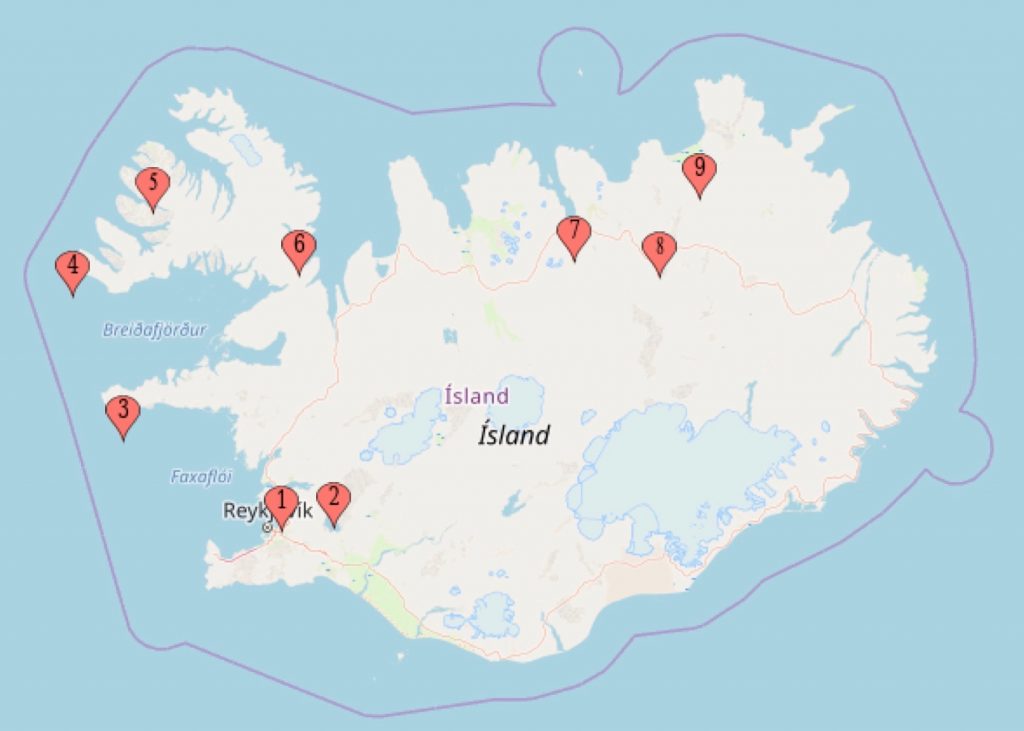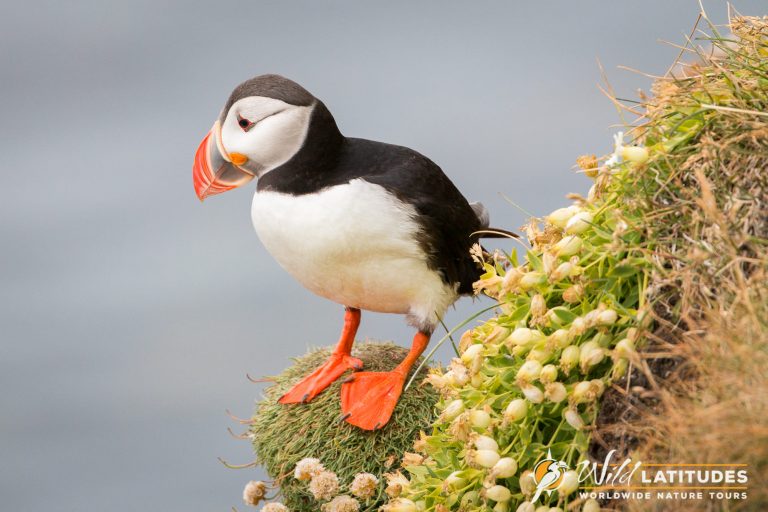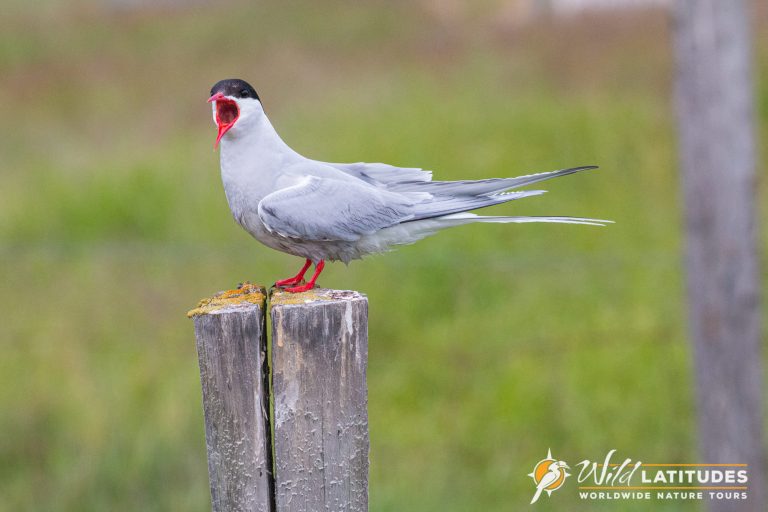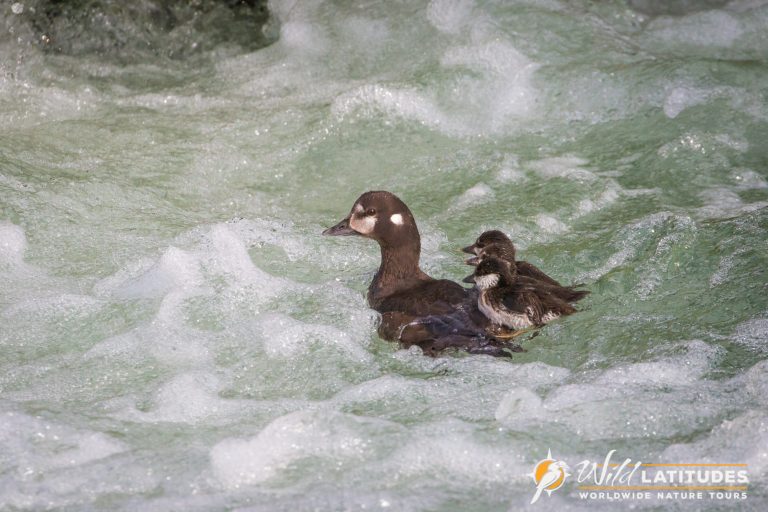The Westernmost WC in Europe: Birding Iceland
By Bob Carloni
My wife Linda and I had wanted to visit Iceland for many years, even before we started birding. Our opportunity came in July, when we joined four other Golden Gate Bird Alliance members and eight other birders from Portland, Minnesota, and points east on an eleven-day Golden Gate Bird Alliance trip there. Led by Ivan Phillipsen and Patty Newland of Wild Latitudes, it was an amazing trip in an amazing land. We sought out not just birds but also interesting plants and geologic and cultural features.
Iceland is the original “land of ice and fire.” Sitting atop the mid-Atlantic Ridge, a tectonic spreading zone, it is a country of vast lava fields that have been sculpted by glaciers. Although located just south of the Arctic Circle, the weather is moderated by the Gulf Stream. Temperatures were typically in the 60s. The sky was often overcast and dressing in layers was a must. Those of us who live near the San Francisco Bay felt right at home.
The number of bird species in Iceland is small (only 77), but the quantity—masses of nesting puffins, razorbills, Northern Fulmar, kittiwake, various sorts of murres and guillemots, and Arctic Terns—more than compensates.

Our trip began in Reykjavik, Iceland’s capital and largest city. Just twenty-five minutes from our centrally located hotel, we visited a pond and a shoreline that yielded several interesting species, including a Purple Sandpiper, Common Shelduck, and Long-Tailed Ducks.
The next day we journeyed along the famous Golden Circle, a well-known route not far from Reykjavik. Our first stop was Thingvellir, a national park on the site of the world’s oldest continuous parliament, which was established in 930 CE. Here we saw White Wagtails and Red-Throated Loons in breeding plumage. We visited several notable geological sites: The east edge of the North American tectonic plate; Geysir, the one for which all other geysers are named; and the incredible Gullfoss Falls.

Note 1: In July, the sun “sets” ( it gets a little dusky) at 1 a.m. and rises at 4 a.m. Even the best blackout shade leaks enough light at the edges to make sleeping difficult at times.
From Reykjavik, we proceeded in vans nicknamed for our guides (the “I-van” and the “Patty Wagon”) through the Snaefellsnes Peninsula on the western side of Iceland. We would become very familiar with these vans, as we traveled many miles in them. Many roads were dirt and gravel, but they were well graded and not uncomfortable. We made our way towards the wilds of northwest Iceland – the Westfjords. As its name suggests, it is a land deeply incised by many fjords. This was the westernmost tip of Europe.
We boarded a ferry to take us to an overnight stop at Flatey Island. This was seabird and shorebird territory. On the ferry, we saw Atlantic Puffins, Common Murres, and Black-Legged Kittiwakes. On the island, we saw European Oystercatchers, Snow Buntings, and Red-Necked Phalaropes in breeding plumage. We encountered the ubiquitous Arctic Terns, fiercely defending their nests.


Note 2: Always wear a hat or carry a tall pole when near the nesting areas of Arctic Terns. Otherwise you risk a head wound when they dive-bomb.
The next morning, we completed our ferry trip and ventured over rocky hills to the Latrabjarg seabird cliffs. There we were able to approach Atlantic Puffins within just a few meters. On the cliffs we observed nesting murres, Northern Fulmars, and Razorbills. Near these cliffs we encountered the westernmost WC in Europe. Flush toilets and running water, miles from the nearest town – amazing and much appreciated.
After a long drive to our hotel, we spent the night at Isafjordur. The next morning, we headed out by boat to spend the day at the Hornstrandir Nature Preserve. This was our closest approach to the Arctic Circle, which was perhaps only twenty-five miles further north. We took a mucky hike along the shore during which we passed a forest of 9-inch-tall mature birches. (It is not a hospitable area in the winter.) On our way back, we were rewarded with Harlequin Ducks in a creek.

From the Westfjords, we ventured east to northern Iceland, first spending a day at Heydalur. Important sightings included King Eiders and Parasitic Jaegers. We enjoyed a half-day break to sit in a thermal pool and have some laundry done.
The next morning, we headed further east towards Arkureyri, Iceland’s second largest city, and the region surrounding Lake Myvatn. On our way, we stopped at Glaumbaer, a reconstructed 1000-year-old farm. Further along, we spotted a gaggle of Pink-footed Geese in a farm field.

We spent four days in this area. Lake Myvatn is a world birding hotspot and home to a wide variety of ducks. It is also volcanic and geothermally active, much like Yellowstone. During our first day-and-a-half here, we were accompanied by a local guide, Guakur, who has been birding for more than fifty years. Within minutes of our start we were looking at an Arctic Loon (rare even for Iceland), with a Common Loon (locally known as a Northern Diver) close by for comparison. Later, he found us Gyrfalcons and a Northern Lapwing. Finally, on the nearby Tjornes Peninsula we saw Great Skuas.

Note 3: Who knew? There are no woodpeckers in Iceland.
Then it was time for more geology. We visited Asbyrgi Canyon, which legend says is the hoofprint of Odin’s horse. Later we barely avoided a downpour at another spectacular waterfall, Dettifoss. The next day, we visited the lava towers of Dimmunuborg. We visited a geothermal power plant, and an area with fumaroles and mudpots. Nearby is a large public thermal pool – soaking in such pools is very popular in Iceland.
On our last day, we made a quick stop at yet another incredible waterfall, Godafoss, for the obligatory group photo. We then flew from Arkureyri over the central highlands back to Reykjavik. Alas, the glaciers and volcanoes below were obscured by clouds. At Reykjavik, we bid farewell to our new friends.
Note 4: Fish, lamb, potatoes, and more fish are the mainstays of the local menus. The fish was delicious, fortunately. The local breads were also delicious. Oddly, there was no decaffeinated coffee to be found anywhere.
We never encountered mosquitoes, but there were many tiny flies, especially near Lake Myvatn. They didn’t bite but certainly made a nuisance of themselves, flying into ears, nose, and mouth. Frequent wind kept them at bay much of the time.

The species count for the trip was 61, including 27 life birds for us. In addition, we saw five mammals, including an Arctic fox (in brown plumage) and a whale of unspecified type.
If you have the opportunity, go to Iceland! It is far and it is expensive, but it is a land like none we had ever seen. We could not recommend it more.

Bob Carloni lives in Alameda. He and his wife Linda have been birding for perhaps a dozen years. He grew up in Ohio, well before he got interested in birding. He has a special attachment to Northern Cardinals, which he once saw daily, but which now seem to elude him. His favorite California birds are ducks; large, slow moving shorebirds; and other easy-to-identify birds.
Did Bob’s story kindle your wanderlust? Our Travel with GGBA program offers a wide range of expertly-guided birding tours in 2020. Trips with spaces still available include Baja California, Southeastern Arizona, Ohio for Spring Migration, Australia, and Brazil. In 2021, we have a Bhutan trip already scheduled! See our Travel with GGBA web page.
